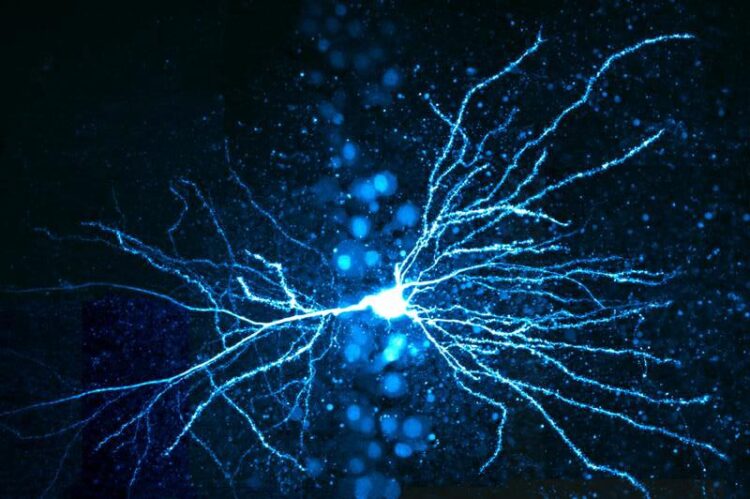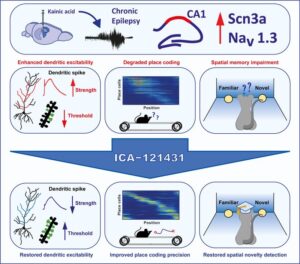New findings on memory impairment in epilepsy

Place cell of the mouse: The dendrites are easily recognizable thanks to the blue fluorescence staining. This is where location information is integrated.
Credit: © Dr. Nicola Masala / University of Bonn
Study by the University of Bonn elucidates a potential mechanism.
Suppose you go to visit an acquaintance you have not been to see in a long time. Nevertheless, you ring the correct doorbell without hesitation: The apple tree in the front yard with the wooden birdhouse next to it, the bright red painted fence, the clinkered facade – all this signals that you are in the right place.
Each place has numerous characteristics that distinguish it and make it unmistakable as a whole. In order to remember a place, we therefore need to store the combination of these features (this can also include sounds or smells). Because only then can we confidently recognize it when we visit it again, and tell it apart from similar places.
It is possible that this retention of the exact combination of features is impaired in people with chronic epilepsy. At least the findings of the current study point in this direction. “In the study, we looked at neurons in the hippocampus of mice,” explains neuroscientist Dr. Nicola Masala of the Institute of Experimental Epileptology and Cognitive Sciences at the University Hospital Bonn.
Specific neurons fire when a place is visited
The hippocampus is a region in the brain that plays a central role in memory processes. This is especially true for spatial memory: “In the hippocampus there are so-called place cells,” Masala says. “These help us remember places we have visited.” There are about one million different place cells in the mouse hippocampus. And each responds to a combination of specific environmental characteristics. So, to put it simply, there is also a place cell for “apple tree/birdhouse/fence”.

In mice with epilepsy, the dendrites are too easily excitable (center). As a result, the stored information is so unspecific that familiar places can no longer be reliably recognized.
Credit: © Dr. Nicola Masala / University of Bonn
But how is it ensured that the place cell only responds to a combination of these three features? This is ensured by a mechanism known as “dendritic integration”. Because place cells have long extensions, the dendrites. These are dotted with numerous contact points where the information that the senses convey to us about a place is received (de facto, there are often hundreds or thousands of them). These contacts are called synapses. When signals arrive at many neighboring synapses at the same time, a strong voltage pulse may form in the dendrite – a so-called dendritic spike.
In this way, the dendrite integrates different types of location information. Only when they all come together it may generate a spike. And only then is this combination stored, so that we recognize the house of our acquaintance the next time we visit it.
“In mice with epilepsy, however, this process is impaired,” explains Prof. Dr. Heinz Beck, in whose research group Dr. Masala did her doctorate and who is also speaker of the Transdisciplinary Research Area “Life and Health” at the University of Bonn. “In them, the spikes already occur when only a few synapses are stimulated. Nor does the stimulation have to occur at exactly the same time.” One might say: The place cells of the sick rodents do not look so carefully. They fire at all the houses with an apple tree in the front yard. As a result, the information stored is less specific. “We were able to show in our experiments that the affected animals had significantly greater problems distinguishing familiar places from unfamiliar ones,” Masala points out.
Active substances improve memory
But what is the reason for this? For a spike to form, large amounts of electrically charged particles (the ions) must flow into the cell. For this purpose, pores open in the membrane that surrounds the dendrite – the ion channels. “In our lab animals, a special channel for sodium ions was significantly more prevalent than normal in the dendrite membrane,” Dr. Tony Kelly of the Institute of Experimental Epileptology and Cognitive Sciences, who co-supervised the study, explains. “This means that just a few poorly synchronized stimuli at the synapses are enough to open many channels and elicit a spike.”
There are inhibitors that very specifically block the affected channel, preventing the influx of sodium ions. “We administered such a substance to the animals,” Masala says. “This normalized the firing behavior of their dendrites. They were also better able to remember places they had visited.”
The study thus provides insight into the processes involved in memory retrieval. In addition, in the medium term it gives rise to hopes of producing new drugs that can be used to improve the memory of epilepsy patients. These promising results are also the result of fruitful cooperation, Masala emphasizes: “Without the collaboration especially with the laboratories of Prof. Dr. Sandra Blaess, Prof. Dr. Laura Ewell and Prof. Dr. Christian Henneberger at the University of Bonn, this success would not have been possible.”
Participating institutions:
In addition to the University Hospital Bonn and the University of Bonn, the German Center for Neurodegenerative Diseases (DZNE), University College London and the University of California, Irvine, were involved in the study.
Journal: Brain
DOI: 10.1093/brain/awac455
Article Title: Targeting aberrant dendritic integration to treat cognitive comorbidities of epilepsy
Media Contact
All latest news from the category: Life Sciences and Chemistry
Articles and reports from the Life Sciences and chemistry area deal with applied and basic research into modern biology, chemistry and human medicine.
Valuable information can be found on a range of life sciences fields including bacteriology, biochemistry, bionics, bioinformatics, biophysics, biotechnology, genetics, geobotany, human biology, marine biology, microbiology, molecular biology, cellular biology, zoology, bioinorganic chemistry, microchemistry and environmental chemistry.
Newest articles

First-of-its-kind study uses remote sensing to monitor plastic debris in rivers and lakes
Remote sensing creates a cost-effective solution to monitoring plastic pollution. A first-of-its-kind study from researchers at the University of Minnesota Twin Cities shows how remote sensing can help monitor and…

Laser-based artificial neuron mimics nerve cell functions at lightning speed
With a processing speed a billion times faster than nature, chip-based laser neuron could help advance AI tasks such as pattern recognition and sequence prediction. Researchers have developed a laser-based…

Optimising the processing of plastic waste
Just one look in the yellow bin reveals a colourful jumble of different types of plastic. However, the purer and more uniform plastic waste is, the easier it is to…



